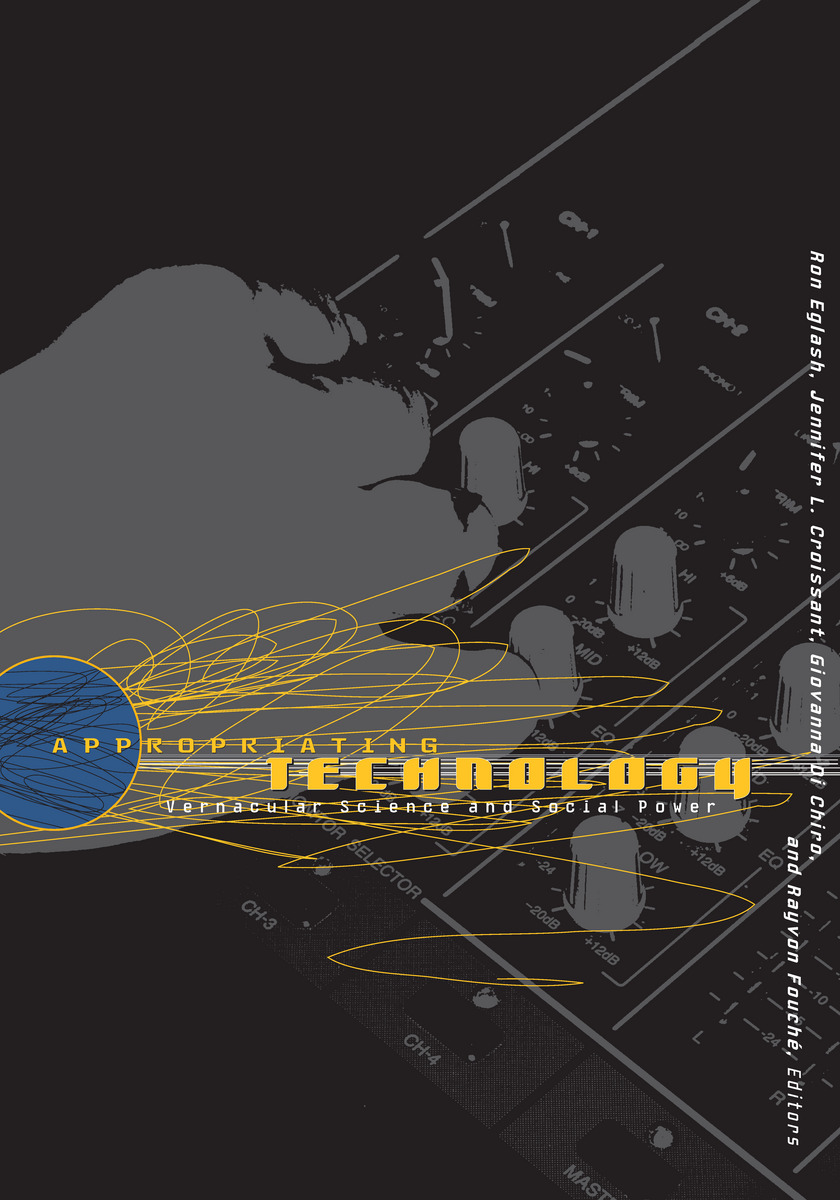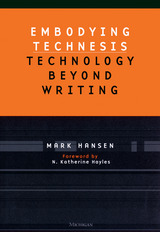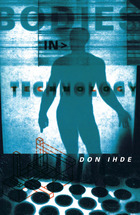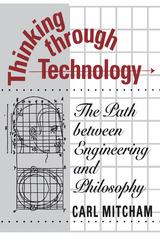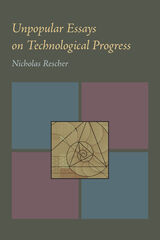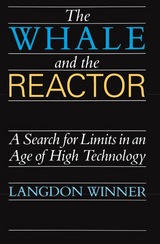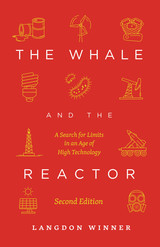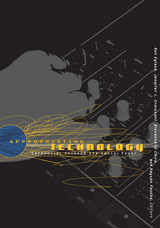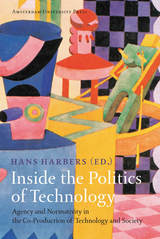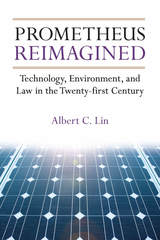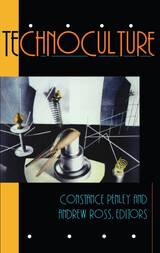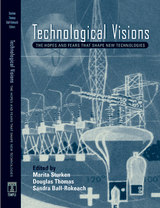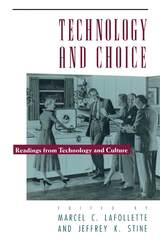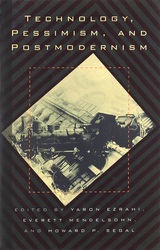Appropriating Technology: Vernacular Science And Social Power
by Ron Eglash
contributions by Jennifer Croissant, Giovanna Di Chiro and Rayvon Fouche
contributions by Jennifer Croissant, Giovanna Di Chiro and Rayvon Fouche
University of Minnesota Press, 2004
Cloth: 978-0-8166-3426-2 | Paper: 978-0-8166-3427-9
Library of Congress Classification T14.5.A68 2004
Dewey Decimal Classification 306.46
Cloth: 978-0-8166-3426-2 | Paper: 978-0-8166-3427-9
Library of Congress Classification T14.5.A68 2004
Dewey Decimal Classification 306.46
TOC
TABLE OF CONTENTS
Contents
Appropriating Technology: An Introduction
Ron Eglash
I. Body Tech Edited by Jennifer L. Croissant
1. The Uses of Scientific Fact: Pasteur's Public Experiment on Anthrax in the Popular Press of the Time
Massimiano Bucchi
2. The Bodybuilder's Pharmacy
Jennifer L. Croissant
3. "All in My Bag of Tricks": Turning a Trick with the Appropriate(d) Technology
Lisa Jean Moore
4. Anal Sex and the Female Condom: Are Gay Men Getting a Bum Wrap?
Michael Scarce
5. Border Skirmishes: Gender, New Technologies, and the Persistence of Structure
Hank Bromley
II. Information Technologies Edited by Ron Eglash
6. The Scratch Is Hip-hop: Appropriating the Phonographic Medium
David Albert Mhadi Goldberg
7. Cultural Paths to Computing: African American Women in a Community Technology Center
Samuel M. Hampton
8. Cyberfeminism Meets NAFTAzteca: Recoding the Technotext
Virginia Eubanks
9. Propagating Alternative Journalism through Social Justice Cyberspace: The Appropriation of Computer Networks for Alternative Media Development in the 1990s
Brian Martin Murphy
10. The American Indian Computer Art Project: An Interview with Turtle Heart
Ron Eglash
III. Environments Edited by Giovanna Di Chiro
11. Science by the People: Grassroots Environmental Monitoring and the Debate over Scientific Expertise
Michael K. Heiman
12. Local Actions, Global Visions: Remaking Environmental Expertise
Giovanna Di Chiro
13. The Use of Computerized GIS Mapping Systems in the Struggle for Environmental Justice
Carmen M. Concepción
14. Encounters between Community-Based Knowledge and Environmental Science: An Interview with Linda Price King
Giovanna Di Chiro
15. Appropriate/d Technology, Cultural Revival, and Environmental Activism: A Native American Case Study
Valerie Kuletz
16. "Whose Trees/Interpretations Are These?" Bridging the Divide between Subjects and Outsider-Researchers
Peter Taylor
IV. Invention Edited by Rayvon Fouché
17. Not Made for Black History Month: Lewis Latimer and Technological Assimilation
Rayvon Fouché
18. Unexpected Pleasures: Phonographs and Cultural Identities in America, 1895-1915
Lisa Gitelman
19. Close Encounters of Another Kind: Young Gay Men and the Technological Self
Richard M. Benjamin
20. Up the Vélorution: Appropriating the Bicycle and the Politics of Technology
Paul Rosen
Contributors
Index
Appropriating Technology: An Introduction
Ron Eglash
Most social studies of science and technology have focused either on production of science and technology by established professionals or on the impact of science and technology on the general public. But what about the lay public as producers of technology and science? From the vernacular engineering of Latino car designers to environmental analysis among rural women, groups outside the centers of scientific power persistently defy the notion that they are merely passive recipients of technological products and scientific knowledge. Rather, there are many instances in which they reinvent these products and rethink these knowledge systems, often in ways that embody critique, resistance, or outright revolt. This book presents the first collection of case studies of such instances of appropriated science and technology. For shorthand we refer to these as "appropriated technologies," but keep in mind that they are often as much about scientific knowledge and ideas as they are about gadgets and technical methods-that is, they encompass the entire realm of "technoscience."1
What Are Appropriated Technologies?
Sociologists, anthropologists, historians, and other researchers have recently converged in a new field termed science and technology studies (STS). Many of the studies undertaken in this field have been framed in terms of "social impact," examining how science and technology change our personal lives or cultural attitudes or environment. Another approach to STS, dating back to the work of Robert Merton in the 1930s, studies science itself as a social phenomenon. Recently this has produced some heated debates about just how much social processes actually influence scientific and technological research. Other STS research clusters have been built around policy studies, ethics and values in science, the anthropology of medicine, and so on.
Despite this diversity of approaches, the vast majority of these studies focus on the professional as the producer. This approach is so frequently used that alternatives can easily be overlooked. As social scientist Manuel Castells (1996) suggests, one way to make the relations between society and technoscience more visible is to think about a "space of flows" in which we map not just geographic locations, but the networks of information and paths of material transport that increasingly define a knowledge-based economy. Here we extend visualizations of this space of flows to even more intangible attributes of people and power-not as a way to reduce social dynamics to a single point of view, but rather the opposite, to expand our ability to understand appropriated technologies from a greater variety of perspectives.2
Figure I.1 shows how the standard view of science and technology might be visualized. On the vertical axis we have "social power," with some well-to-do professionals at the top and some hard-knock blue-collar folks at the bottom. Granted, there are hundreds of different aspects of social power(some obvious, such as financial assets, political legitimacy, or religious authority, and some more subtle, such as the often unconscious bias against personal appearance (ethnicity, gender, age, beauty)(that can emerge in even the most nondiscriminatory of circumstances. Moreover, these different aspects of social power can conflict with each other. A penniless prophet might hold thousands in his sway, while a lonely, rich atheist might mold society by money. So when producing this type of graph we need to remember that there are many different ways a single case study could be drawn, depending on the focus of the analysis.
[FIGURE I.1 HERE]
Let us assume that we have agreed upon some particular category or dimension of social power, such as income, which lands our scientists or engineers in this study toward the upper half of the scale (roughly analogous to the upper middle class of American society). Now we want chart the flow of artifacts or ideas as they leave the laboratory and find their way to consumers. For this task we will need the horizontal axis of Figure I.1, the consumption-production axis. Again, there is no reason to think of this single dimension as simultaneously representing the hundreds of different consumption/production aspects of our lives; we take it that the graph is trying to show only a single aspect of one product. If we divide our consumers into two groups-the rich and the poor-we have two paths from the professional producers, as shown in Figure I.1. Of course the graph indicates only the general direction of the flow in terms of these two dimensions; in physical time and space these paths might be quite complex, with knowledge that slowly diffuses to the public or circuitous routes from design lab to factory floor to shops to home (cf. Cowan 1987).
Even with such a simplified view, there are many instances that do not fit this picture. The best known are those of the ethnosciences, for example, ethnomathematics or ethnobotany (Figure I.2). The members of an indigenous society may be at the margins of political and economic power, but their knowledge systems can produce information that winds up in a first world high-tech laboratory. For example, indigenous herbal cures developed through ethnopharmacology can lead to high profits in the biotechnology industry. Of course that does not necessarily mean high profits for the indigenous herbalists; in fact, their knowledge is often appropriated without compensation.
[FIGURE I.2 HERE]
Appropriation, however, can be a two-way street, and it is the traffic in the opposite direction that concerns us. The case studies presented in this book show how people outside the centers of social power-from white middle-class homemakers to rural Native Americans-have been able to use materials and knowledge from professional science for their own kinds of technological production. In these instances of appropriated technologies (Figure I.3) we begin with production at the usual professional locations, but it is followed by a second phase in which this technoscience is reinterpreted, adapted, or reinvented by those outside these centers of power. Of course the trajectory need not stop there. Such innovations can reappear in professional contexts, be mixed with indigenous knowledge, and enter into further appropriations from either the top or the bottom of the scale.
[FIGURE I.3 HERE]
Why Study Appropriated Technologies?
Many of the researchers in social studies of science have entered the field because of their concern over the real and potential dangers involved in science and technology. For this reason the field has gained a reputation for pessimistic views, and critics sometimes accuse them of being technophobes or Luddites. Appropriated technologies offer a rich resource for combining a critical analysis of social issues with an eye toward the positive application of science and its artifacts. Of course not all of these case studies are happy stories: neo-Nazi groups are also outside the centers of scientific production, and they too adapt and reinvent the products of such centers to gain power. The stories of technological appropriations are multifaceted; they are both painful and joyous, reassuring and shocking. They are complex enough to warrant study for their own sake. But their primary importance is in terms of their potential contribution to sociopolitical resistance and social reconfiguration.
Variations in the Consumption-Production Dimension
In collecting the various case studies for this anthology, it became apparent that some examples made a stronger case for appropriation than others. Using that distinction, we developed the following three analytic categories, positioned along the consumption-production axis (Figure I.4).
[FIGURE I.4 HERE]
The weakest case is made by examples in the category we call reinterpretation, which is defined by a change in semantic association, with little or no change in use or structure. Graffiti tags are a good illustration: the physical and functional aspects of a building are essentially unchanged by such tags, but the semantic claim to possession indicated by these tags, as a form of either cultural resistance or criminal turf war, is not trivial (Castleman 1982; Rose 1994). The next-stronger case is made by examples in the category we call adaptation, which is defined by a change in both semantic association and use. For example, the Bedouin society of Egypt, a relatively disempowered ethnic minority, found that cassette tape players, which were marketed for listening to music from the Egyptian majority, had an unused recording capability as well. They began to record their own songs, and this eventually led to the rise of a Bedouin pop star and the creation of new economic and cultural opportunities (Abu-Lughod 1989). Adaptation requires two technosocial features. First, it requires an attribute of the technology-user relationship that Hess (1995) refers to as "flexibility."3 For example, a calculator is less flexible than a word processor, which is less flexible than a personal computer. Second, it requires a violation of the technology's intended purpose. It is a mistake to reduce this to the intentions of the technology's designers; we also need to consider marketing intentions and "common-sense" or popular assumptions. In the case of the Bedouin cassette players we have the preexisting flexibility for recording that was intended by the designers, but this was obscured by the marketing focus on the machines' play-back capability only. Adaptation can be described as the "discovery" of a "latent" function, but that definition needs to be problematized in the same ways that philosophers have debated whether mathematics is invention or discovery (Restivo et al. 1993). The creativity required to look beyond the assumed functions of the technology and see new possibilities is a powerful force for social change, yet one that receives insufficient theoretical attention.
The strongest case for appropriated technology is made by examples in the category we call reinvention, in which the semantics, use, and structure of a technology are all changed. That is, if adaptation can be said to require the discovery of a latent function, reinvention can be defined as the creation of new functions through structural change. Low-rider cars (Figure I.5) provide a clear demonstration of this combination. Although automobile shock absorbers were originally produced for decreasing disturbance, Latino mechanics developed methods for attaching them to electrically controlled air pumps, turning shock absorbers into shock producers. Low-rider cars violate both marketing and design intentions, but the new functionality was introduced by altering the original structure rather than discovering functions lying dormant in the original artifact.
[FIGURE I.5 HERE]
It is important to understand that in distinguishing strong versus weak cases for appropriated technology we make no evaluation of ideology or effectiveness. One might, for instance, have more political success with reinterpretation than reinvention in a given case. But the three categories do offer a useful set of analytic distinctions. Consider, for example, Native American artist Sharol Graves's description of the genesis of her work (Figure I.6):
The image of these serigraph prints started out as a joke. When I worked in the silicon valley, I used to draw on the computer during my lunch hour. I made the computer do things the software wasn't designed to do. I would draw for an hour and save my "Indian design" drawing. Then the computer would crash because of a memory overload. Then, I had to figure out a way to save it another way. When I finally tried to plot out the design on a D-size drafting plotter, I ran into a similar problem. Once again, I was able to figure out a way to manipulate the plotter to draw the entire image (Graves 1995).
[FIGURE I.6 HERE]
Graves first reinterpreted the computer-aided design/computer-aided manufacturing software she was using for circuit design as an artistic medium; she then adapted it for new functionality, and finally she reinvented the system, changing its physical capabilities. She explains, "I wanted the public to know that a Native American was working in the research and development of high technology, just to blow a few stereotypes about the 'Indian Mind.'" For Graves the activities of reinterpretation, adaptation, and reinvention map out a journey that progressively fused cultural and electrical resistance.
Variations in the Social Power Dimension
In considering variation along the social power axis we need to steer between two potential pitfalls. On the one hand, we need to avoid multiculturalist relativism, in which every social group is seen as just another dish in the global smorgasbord (Fraser 1997). On the other hand, we need to avoid a contest for victimhood; we do not want to construct a hierarchy of oppressions. One way to avoid this dilemma is to keep in mind the multidimensional nature of these categories of social power; as noted earlier, each case could be mapped in several different ways. But even if we reduce our analysis to one dimension(for example, racial/ethnic identity-every group and individual must be approached in historic, contextual terms, not as a fixed "essence." Indigenous ("fourth world") societies, for example, can be endangered by the descendants of colonialists, but many of these descendants are themselves ethnic hybrids seeking to contest their own marginal "third world" status. Analyses of appropriated technologies need to consider the historically specific relation between these cultural locations and the turbulent mixtures of people, artifacts, techniques, and texts that make up technoscience.
Consider, for example, the famous case of Kayapo video (Turner 1992). Deep in the Amazon rainforest, the construction of a hydroelectric dam threatens Kayapo lands. The Kayapo use hand-held camcorders, at first to rally support in dispersed villages and later to help document their protest. Despite the Brazilian government's interest in keeping the activism quiet, the images are picked up by the first world press, showing the Kayapo in full war regalia with bright tropical bird feathers juxtaposed against the high-tech camcorders. What could have been an obscure protest becomes an international media event, resulting in political pressure to stop the dam. But how should this be analyzed in regard to appropriated technologies? In one sense, the Kayapo are merely using camcorders the way the Sony corporation intended: to make videos. In terms of the consumption-production dimension, it is quite a weak example of the appropriation of technology. But the Kayapo are not the typical consumers that the Sony engineers had in mind when they created this technology.
First world consumers, especially those from the white middle class, rarely realize the extent to which their technological access is ensured simply by their status as "the users" foremost in so many designers' minds. For example, even something as seemingly universal as photographic film embodies decades of chemical refinement using white-skinned models; similar phenomena exist for furniture, clothing, and many other products.4 When we think about the dimension of consumption-production, we need to keep in mind that some consumers have flows of access to the "production" end of the spectrum that are normally invisible, even to themselves.5 In the case of Kayapo video those paths are nonexistent; the mere fact that the Kayapo were able to translate use of this technology from the first world context in which it was designed (a context that assumes, for example, that there will be electrical outlets with stable power sources available) to the fourth world context of indigenous artifacts and knowledge is in itself an impressive appropriation accomplishment. In other words, movement along the axis of social power is just as important in defining appropriated technologies as movement along the consumption-production axis.
Thus we should think of our graph not as a static map, but as a place to chart the movements of artifacts, ideas, and even people. Movements make visible the contours of social power in relation to technoscience: we sense the difficulty of movement in the "wrong direction," the resistance we encounter when these artifacts, ideas, and people try to flow upstream. We can visualize this difficulty or resistance to uphill flow on our graph by adding a third dimension (Figure I.7).
[FIGURE I.7 HERE]
When I mention appropriated technologies to political conservatives, they sometimes respond with a Horatio Alger story: "Technology lets anyone pull themselves up by their own bootstraps." Figure I.7 helps us to visualize the critique of that myth; it presents a portrait of the forces that unite elite social power and technoscience production and of the pull that keeps disenfranchised groups away from such production. Working-class students struggling in school, for example, often describe their troubles in terms that sound like bad luck-"I missed my exam because I had to take my brother to the hospital" or "My car wouldn't start"-but when we step back and view the whole of such incidents we can see them as like iron filings in a magnetic field, mapping outflows of power.6 As cultural theorists such as Michel Foucault (1988) and N. Katherine Hayles (1984) have pointed out, social power can be so diffuse that it acts more like a force field in physics, a volume filled with electrical or magnetic or gravitational vectors. And that, too, is an appropriation; we need new kinds of literacy that allow more nonscientists to understand and shape the contours of this multidimensional space of flows.
A Brief Survey of Previous Research
Unlike in this anthology, in STS literature the word appropriation typically refers to the context of professional scientists and engineers, such as the Marxist critique of the appropriation of labor by the upper class or the complex portrait recently offered in Hård and Jamison's anthology titled The Intellectual Appropriation of Technology (1998), which describes how professionals have used technology for purposes of romanticism, nationalism,and so on. But the appropriation of science and technology by marginalized groups, as we have defined it here, is a more widespread phenomenon. The following seven categories describe how some of this research has been conceptualized.
The consumption junction. Cowan (1987) charts the relations of consumption and production in the history of cooking stoves, using innovative diagrams that work as topological maps to show the collective force of consumers in shaping technology design through market demands (see also research in "evolutionary economics," e.g., Dosi et al. 1988). Mackay and Gillespie (1992) and Lie and Sorenson (1996) extend this analysis to user adaptation through more detailed examples. Smith and Clancey's anthology (1998) includes a collection of essays on "hobbyist worlds" of innovation, such as Douglas's study of the extraordinary role played by early amateur radio operators.
Vernacular knowledge systems. Vernacular architecture has long been a subject of interest in folk arts and anthropology, particularly where "high culture" components are reassembled into "low culture" structures. Vernacular mathematics is described by Nunes et al. (1993) and Lave (1988), and both Eglash (1995) and Darrah (1995) describe adaptations in information technology that can be termed vernacular cybernetics. Akrich (1992) analyzes vernacular engineering of energy generation in third world development, demonstrating how differences in both technical flexibility and cultural context influence adaptation. Pacey (1983), writing on "Eskimo" adoption of snowmobiles, Manuel (1993) on cassette use in India, and Gupta (1998) on selective synthesis of indigenous and high-tech agricultural knowledge all provide good examples of such vernacular appropriation. Appadurai (1996) and Escobar (1995) discuss some of the broader cultural politics of technological hybrids.
The ambiguity of use. Westrum (1991) describes how the "ambiguity of use" invites adaptation and tinkering: "A device is basically a solution, but there may be more than one problem to which it applies" (239). Tenner (1996) provides an analysis of the "unintended consequences" of technology, such as the dialectic between changes in sports technology and changes in sports activity.
Creative misuse. Penley and Ross (1991) note several cases of "popular refunctioning of foreign technology," such as that of "the Vietnamese farmers who turn bomb craters . . . into fish ponds" (although the authors curiously disregard these as merely "cute" examples, preferring information technology as a more explicitly oppositional political appropriation of technology). Terry and Calvert (1997), focusing on gender, point to groups such as the Barbie Liberation Organization, which switched voice recordings for Barbie dolls with those for G.I. Joes and slipped them into stores across the nation, to emphasize the intentionality of what Terry calls "creative misuse." On a less political note, Hesser (1998) describes the wide variety of culinary innovations, from a panty hose consommé strainer to cedar roof shingles used to serve salmon.
Public understanding of science. Toumey (1996) points to several examples, such as evolution versus creationism, the fluoridation debate, and other public controversies in which the authority of science is brought to play against itself. In the hands of popular groups such debates at times appropriate science using rigorous data and analysis, and at other times are merely "conjuring" the effect of science using its symbols. Irwin and Wynne's (1996) anthology emphasizes the appropriation aspects of certain lay interpretations.
The outsider within. Collins (1987) describes the multiple and sometimes conflicting positions of the African American woman as "the outsider within." This framework in which personal identity and professional identity lie at opposite ends of the social power axis is descriptive of many situations in which marginalized groups move into professional science and technology production. Examples are found in Manning's (1983) study of anti-racist biologist E. E. Just, Koblitz's (1983) biography of feminist mathematician Sophia Kovaleskaia, and instances of others whose upward mobility did not erase an "oppositional consciousness" (Sandoval and Davis 2000).
The Role of Appropriation in Democratizing Science and Technology
Appropriated technologies do not have an inherent ethical advantage. First, insofar as appropriation is a response to marginalization, we should work at obviating the need for it by empowering the marginalized. Second, not all forms of resistance are necessarily beneficial in the long run. Aihwa Ong (1987), for example, notes that Malaysian women using spirit possession as resistance to exploitation may be releasing frustrations that could have gone into collective labor organizing. And as we have already noted, white supremacist groups might well be described as marginalized people who appropriate the Internet and other technologies. While free speech must be preserved at all costs, appropriation is not an ethical win in the case of neo-Nazi Web sites.
Insofar as science and technology appropriations do have the potential to make contributions to stronger democracy (cf. Schuler 1996; Sclove 1995; Winner 1986), we need to understand how these positive attributes can succeed. First, there are obstacles to appropriation itself, most obviously those created by totalitarian governments, but corporations can also dampen or discourage appropriation. The flexibility required to allow user adaptation, for example, is increasingly threatened in contemporary information technology marketing strategies. The best-known case is Microsoft's attempts to secure market share by preventing inclusion of the Netscape Web browser in the Windows operating system, but this strategy of selective compatibility is much more widespread. For example, during the Web browser court inquiry it was revealed that Microsoft had prevented its competition from gaining complete knowledge of all Windows operating system files, which would mean that Microsoft's own application software would be more reliable than that of its competitors. Encouraging designers to incorporate appropriation as a positive virtue would require reversing this trend toward inflexibility. Of course, flexibility itself can be a means of social dominance, as Martin (1994) points out in examining concepts of the embodied self under capitalist relations of "flexible accumulation" (e.g., flexibility as a managerial strategy). Extending Martin's framework to technology design, we might point to the ways in which the increasing flexibility of software allows it to adapt to individual users' computers, making internal changes to its software configurations, linking automatically to company Web sites, and engaging in other activities that blur the line between "enhancement" of user capabilities and serving as a prosthetic for corporate influence.
Second, we can examine each lay/professional relationship in terms of the dependence or independence fostered by various appropriated technology strategies (Figure I.8). Rather than romanticize independence, both users and designers should strive toward the method of appropriation that will move toward strong democracy in their particular context, while allowing for changes such as increasing independence to free up new possibilities or decreasing it to facilitate institutionalization.
[FIGURE I.8 HERE]
Finally, we can encourage, inspire, and incite the use of appropriated technologies for opening new possibilities in the relations of culture and science. Foucault's powerful phrase "technologies of the self" uses technology only in a metaphorical sense, and it is focused on self-making by those at the high end of the social power spectrum, but De Lauretis's Technologies of Gender (1987) brings the apparatus of representation together with discussion of its marginal actors in ways that suggest both the challenge and the promise of appropriation for cultural identity. We need not just more cultural expertise in technical matters, but more syncretism in both directions. We need not only more scientific access for local communities, but more cultural workers-artists, writers, activists, and others-who can animate the spirit of technoscience and speak to the soul of appropriated technologies.
Notes
1. Technoscience is a term introduced by Latour and Woolgar in their seminal text Laboratory Life, in part because repeating the phrase science and technology became tiresome, but with an eye toward critique of the claim for clean separation between the two categories (cf. Oudshoorn's [1993] identification of this blurred boundary in chemistry and engineering). We considered naming this book Appropriating Technoscience, but no one outside the field of science and technology studies (STS) seemed to know what we were talking about, so instead we are leaning on the crutch of this fuzzy boundary.
2. As Haraway (1991, 189-90) notes, the rejection of visualization in cultural critique is based on a faulty assumption that it must always produce a God's-eye view; but any close examination reveals that "there are only highly specific visual possibilities, each with a wonderfully detailed, active, partial way of organizing worlds."
3. Flexibility was originally introduced into STS terminology in reference to the interpretative flexibility of scientific theories by Collins (1981) and was imported into social studies of technology by Pinch and Bijker (1984).
4. Thanks to Rayvon Fouché for the photography example.
5. As Appadurai (1986, 41) puts it, "The production knowledge that is read into a commodity is quite different from the consumption knowledge that is read from the commodity. Of course these two readings will diverge proportionately as the social, temporal, and spatial difference between producers and consumers increases."
6. Foucault (1979, 139-41) describes such "micro-physics of power" in terms of the intentional control of minutiae by those in authority, but here we see a similar force of minutiae without anyone in charge.
Works Cited
Abu-Lughod, Lila. 1989. "Bedouins, Cassettes, and Technologies of Popular Culture." Middle East Report (July-August): 7-11, 47.
Akrich, M. 1992. "The De-scription of Technical objects." In Shaping Technology/Building Society: Studies in Sociotechnical Change, edited by W. E. Bijker and J. Law, 205-40. Cambridge, Mass.: MIT Press.
Appaduri, A., ed. 1986. The Social Life of Things: Commodities in a Cultural Perspective. Cambridge, U.K.: Cambridge University Press.
(((. 1996. Modernity at Large: Cultural Dimensions of Globalization. Minneapolis: University of Minnesota Press.
Bates, Sara, ed. 1995. Indian Humor. San Francisco: American Indian Contemporary Arts.
Castells, Manuel. 1996. The Rise of the Network Society. Malden, Mass: Blackwell.
Castleman, Craig. 1982. Getting Up: Subway Graffiti in New York. Cambridge, Mass.: MIT Press.
Collins, H. M. 1981. "Knowledge and Controversy." Social Studies of Science 11: 3-10.
Collins, Patricia Hill. 1991. Black Femininist Thought: Knowledge, Consciousness, and the Politics of Empowerment. New York: Routledge.
Cowan, Ruth Schwartz. 1987. "The Consumption Junction: A Proposal for Research Strategies in the Sociology of Technology." In The Social Construction of Technological Systems: New Directions in the Sociology and History of Technology, edited by Wiebe E. Bijker, Thomas P. Hughes, and Trevor J. Pinch, 261-80. Cambridge, Mass.: MIT Press.
Darrah, C. N. 1995. "Techno-Guanxi: Connecting Relationships and Icons through Technology." Paper presented at the American Anthropological Association annual meeting, Washington, D.C..
De Lauretis, Teresa. 1987. Technologies of Gender. Bloomington: Indiana University Press.
Dosi, G., et al. 1988. Technological Change and Economic Theory. New York: Pinter.
Eglash, R. 1995. "African Influences in Cybernetics." In The Cyborg Handbook, edited by Chris Gray. New York: Routledge.
Escobar, A. 1995. Encountering Development: The Making and Unmaking of the Third World. Princeton, N.J.: Princeton University Press..
Foucault, Michel. 1979. Discipline and Punish: The Birth of the Prison, translated by Alan Sheridan. New York: Vintage Books.
(((. 1988. "Technologies of the Self." In Technologies of the Self: A Seminar with Michel Foucault, edited by L. Martin, H. Gutman, and P. Hutton, 16-49. Amherst: University of Massachusetts Press.
Fraser, Nancy. 1997. Justice Interruptus: Critical Reflections on the "Postsocialist" Condition. New York: Routledge.
Graves, Sharol. 1995. "Indian Circuit." In Indian Humor, edited by Sara Bates. San Francisco: American Indian Contemporary Arts.
Gupta, A. 1998. Postcolonial Developments: Agriculture in the Making of Modern India. Durham: Duke University Press.
Haraway, Donna. 1991. Simians, Cyborgs and Women: The Reinvention of Nature. New York: Routledge.
Hård, Mikael, and Andrew Jamison, eds. 1998. The Intellectual Appropriation of Technology: Discourses on Modernity, 1900-1939. Cambridge, Mass.: MIT Press.
Hayles, N. Katherine. 1984. The Cosmic Web: Scientific Field Models and Literary Strategies in the Twentieth Century. Ithaca: Cornell University Press.
Hess, D. 1995. Science and Technology in a Multicultural World. New York: Columbia University Press.
Hesser, Amanda. 1998. "Quick, Hide the Tools. Here Comes a Chef." New York Times, September 16, Dining In, Dining Out/Style Desk, 1.
Irwin, Alan, and Brian Wynne. 1996. Misunderstanding Science? Cambridge, U.K.: Cambridge University Press.
Koblitz, Ann Hibner. 1983. A Convergence of Lives: Sofia Kovalevskaia: Scientist, Writer, Revolutionary. New Brunswick, N.J.: Rutgers University Press.
Lave, J. 1988. Cognition in Practice. New York: Cambridge University Press.
Lie, Merete, and Knut H. S_rensen, eds. 1996. Making Technology Our Own? Domesticating Technology into Everyday Life. Oslo: Scandinavian University Press.
Mackay, Hughie, and Gareth Gillespie. 1992. "Extending the Social Shaping of Technology Approach: Ideology and Appropriation." Social Studies of Science 22: 685-716.
Manning, Kenneth R. 1983. Black Apollo of Science: The life of Ernest Everett Just. New York: Oxford University Press.
Manuel, P. 1993. Cassette Culture: Popular Music and Technology in North India. Chicago: University of Chicago Press.
Martin, Emily. 1994. Flexible Bodies: Tracking Immunity in America from the Days of Polio to the Age of AIDS. Boston: Beacon Press.
Nunes, Terezinha, Analucia Dias Schliemann, and David William Carraher. 1993. Street Mathematics and School Mathematics. Cambridge, U.K.: Cambridge University Press.
Ong, Aihwa. 1987. Spirits of Resistance and Capitalist Discipline: Factory Women in Malaysia. Albany: State University of New York Press.
Oudshoorn, N. 1993. "United We Stand: The Pharmaceutical Industry, Laboratory, and Clinic in the Development of Sex Hormones into Scientific Drugs, 1920-1940." Science, Technology and Human Values 18 (1): 5-24.
Pacey, A. 1983. The Culture of Technology. Cambridge, Mass.: MIT Press.
Penley, Constance, and Andrew Ross, eds. 1991. Technoculture. Minneapolis: University of Minnesota Press.
Pinch, Trevor J., and Wiebe E. Bijker. 1984. "The Social Construction of Facts and Artifacts: Or How the Sociology of Science and the Sociology of Technology Might Benefit Each Other." Social Studies of Science 14: 399-441.
Restivo, Sal, Jean Paul Van Bendegem, and Roland Fischer, eds. 1993. Math Worlds: Philosophical and Social Studies of Mathematics and Mathematics Education. Albany: State University of New York Press.
Rose, T. 1994. Black Noise. Hanover, N.H.: Wesleyan University Press.
Sandoval, Chela, and Angela Y. Davis. 2000. Methodology of the Oppressed. Minneapolis: University of Minnesota Press.
Schuler, Douglas. 1996. New Community Networks: Wired for Change. New York: Addison-Wesley.
Sclove, Richard. 1995. Democracy and Technology. New York: Guilford Press.
Tenner, Edward. 1996. Why Things Bite Back: Technology and the Revenge of Unintended Consequences. New York: Knopf.
Terry, Jennifer, and Melodie Calvert, eds. 1997. Processed Lives: Gender and Technology in Everyday Life. New York: Routledge.
Toumey, Christopher. 1996. Conjuring Science. New Brunswick, N.J.: Rutgers University Press.
Turner, Terrence. 1992. "Defiant Images: The Kayapo Appropriation of Video." Anthropology Today 8 (6): 5-16.
Westrum, Ron. 1991. Technologies and Society: The Shaping of People and Things. Belmont, Calif.: Wadsworth Publishing Co.
Winner, Langdon. 1986. The Whale and the Reactor: A Search for Limits in an Age of High Technology. Chicago: University of Chicago Press.
I. Body Tech
Edited by Jennifer L. Croissant
Body Tech
The five chapters in this section are representative of only a small subset of all possible topics concerning appropriated technologies, health, sexuality, and identity. From each we get some sense of the various meanings of the word appropriated and a sense of the centrality of knowledge and artifacts in constructing identities. Each is concerned with the body on a different scale, from that of publicly held theories of health, illness, and identity to that of privately enacted practices.
Massimiano Bucchi examines how the public shaped the meaning of Pasteur's immunization research. The public framed and appropriated this work, especially in relation to controversies over vivisection, homeopathy, and vaccination. In Bucchi's account, people resisted compulsory vaccination on the grounds that it was either ineffective or too risky. Without alternative research practices to animal inoculations and tests, antivivisectionists recommended homeopathic medicines as humane and effective treatments. The facts and practices of experimentation were used by various sides in a number of debates, and the long battle that ensued was won unevenly.
In my contribution I am concerned, like Bucchi, with popular medical knowledge, which shapes the interpretation of formal medical knowledge and, on occasion, contributes to it. I discuss the pharmaceutical knowledge that elite bodybuilders manage and the models of science and expertise they use to evaluate knowledge claims. I also assess food knowledge, and also some slipperiness among cultural and legal categories of foods and drugs, which manufacturers and users manipulate toward their own ends. Bodybuilding is an activity in which the body can be treated as a technology of self, a means of self-expression and communication, and a way of displaying identity. I examine some ambiguities of current bodybuilding norms in relation to ideas about sexuality, and I conclude the chapter with a discussion of some implications of the distribution of bodybuilding knowledge, products, and practices for different sectors, particularly U.S. youth.
Lisa Jean Moore presents rich data from interviews with sex workers, allowing us to hear from them how they adopt, adapt, or reject different technologies that are candidates for safer sex practices. We also hear how these workers' clients are educated about safer sex, and we gain insight into how new practices work their way from individual choices and actions, through social movements, marketing, and general diffusion of innovations, into mainstream definitions and practices. We are encouraged to think about what is made possible by technology (its "affordances"), what is desirable or appropriate for a given technology, and what is appropriable or taken beyond the initial imaginings for a technological resource.
Michael Scarce presents a case study of the approval process for female condoms. He highlights the role that heteronormative politics have played in the testing and marketing of these artifacts. However, the gay community has appropriated this technology and developed its own discourse of safe sex practices, distributing this information through various media and developing an alternative account of the use and effectiveness of female condoms. Finally, Hank Bromley closes this section with some ideas about the limits for appropriating technologies of the self, in this case investigating the effectiveness of boundary-blurring strategies. In transgender discourse, for example, Bromley notes how some frameworks can reify normative gender orders even while destabilizing other parts of the gender and technology continuum.
All of the chapters are concerned with bodily hexis, the point at which individual habit or praxis and environment meet, the place where behavior is constrained and enabled by the co-constitutiveness of available resources, cultural patterns, and individual preferences. The contributions are also concerned with social movements, subcultures, and public awareness of science and technology. For example, it might be difficult to imagine bodybuilding as a social movement, especially given its commercialization, but it has vestigial characteristics of the earlier fitness movements that provide its backdrop (Whorton, 1982). Not all of the characteristics of these movements were or are benign, for they included things such as racial purity, masculinist chauvinism, and nationalist agendas. But in context, fitness crusaders such as the Kellogg company promoted whole and pure foods and, in its concern for the health of nations, promoted attention to issues of nutrition and poverty. When one factors in charismatic leadership, social reform agendas, and the demands on individual members' time, behaviors, and identities, the distinction between a subculture (which is a rather static conception of nonmainstream participation in public life) and a social movement (which has a time orientation and sense of direction that the concept of subculture does not) becomes apparent. In their own ways, all these chapters address the questions of the goal-oriented and private or collective identity questions that people use technology to articulate. Both Bucchi and Bromely are centrally concerned with the issues of public knowledge and social movements. All of the chapters are in the spirit of other studies of women's health activities, whether the formation of women's health collectives or the struggles of midwifery to find appropriate cultural and legal spaces in which to practice.
Of course a whole universe of recent and future studies addresses this area. Additional studies include the rapidly expanding discourse on prosthetic technologies, both those used by people with disabilities and those used more metaphorically as somatic or cognitive extensions. Or consider Jonathan Coopersmith (1998), who discusses the pornography industry as an important but overlooked example of the complexity of producer-consumer distinctions. New media technologies are contributing to the eradication of distinctions between producers, distributors, and consumers, from do-it-yourself pornographic video and Web site production to innovations designed in the industry that expand the available bandwidth and diffuse information to mainstream media (94). As an industry, pornography might be praised and studied for its patterns of rapid innovation and adoption of new technologies, except that the content of the industry is so problematic (95).
In other dimensions, the emergence of "alternative" health practices in mainstream Western culture and within formal medical research institutions is a multifaceted case that includes a rapidly evolving herbal industry, changes in health care provision systems, and consumer-driven searches for alternatives. To label these practices "alternative" reifies the legitimacy of mainstream medical knowledge and medical institutions, but such is the nature of hegemonic discourses that have the power to set the terms of discourse and analysis. This is one of the key challenges to theorizing appropriated technologies and related studies regarding the public understanding, use, and production of knowledge and science. Appropriation certainly articulates well with Western cultural motifs of independence and innovation and with notions of self-determination for larger collectives. The real power of the appropriated technology framework, hinted at in each of these selections, is the move beyond the continual reference to existing structures of power to mapping the transformative effects of ideas and practices that a move from periphery to center may have on the terms of discourse and practice.
Library of Congress Subject Headings for this publication: Technology Social aspects, Appropriate technology
See other books on: Appropriate technology | Croissant, Jennifer | Di Chiro, Giovanna | Eglash, Ron | Social Power
See other titles from University of Minnesota Press
